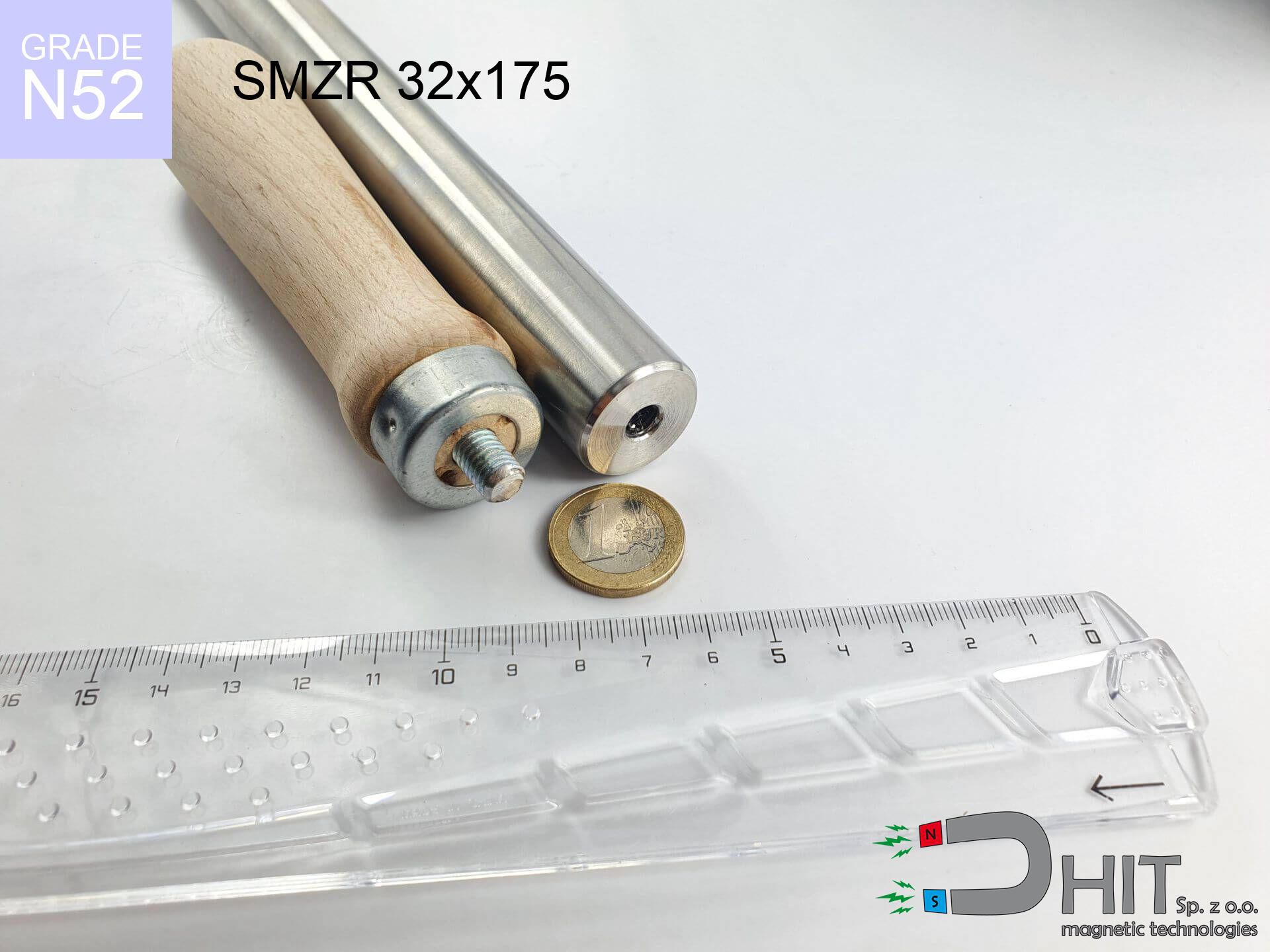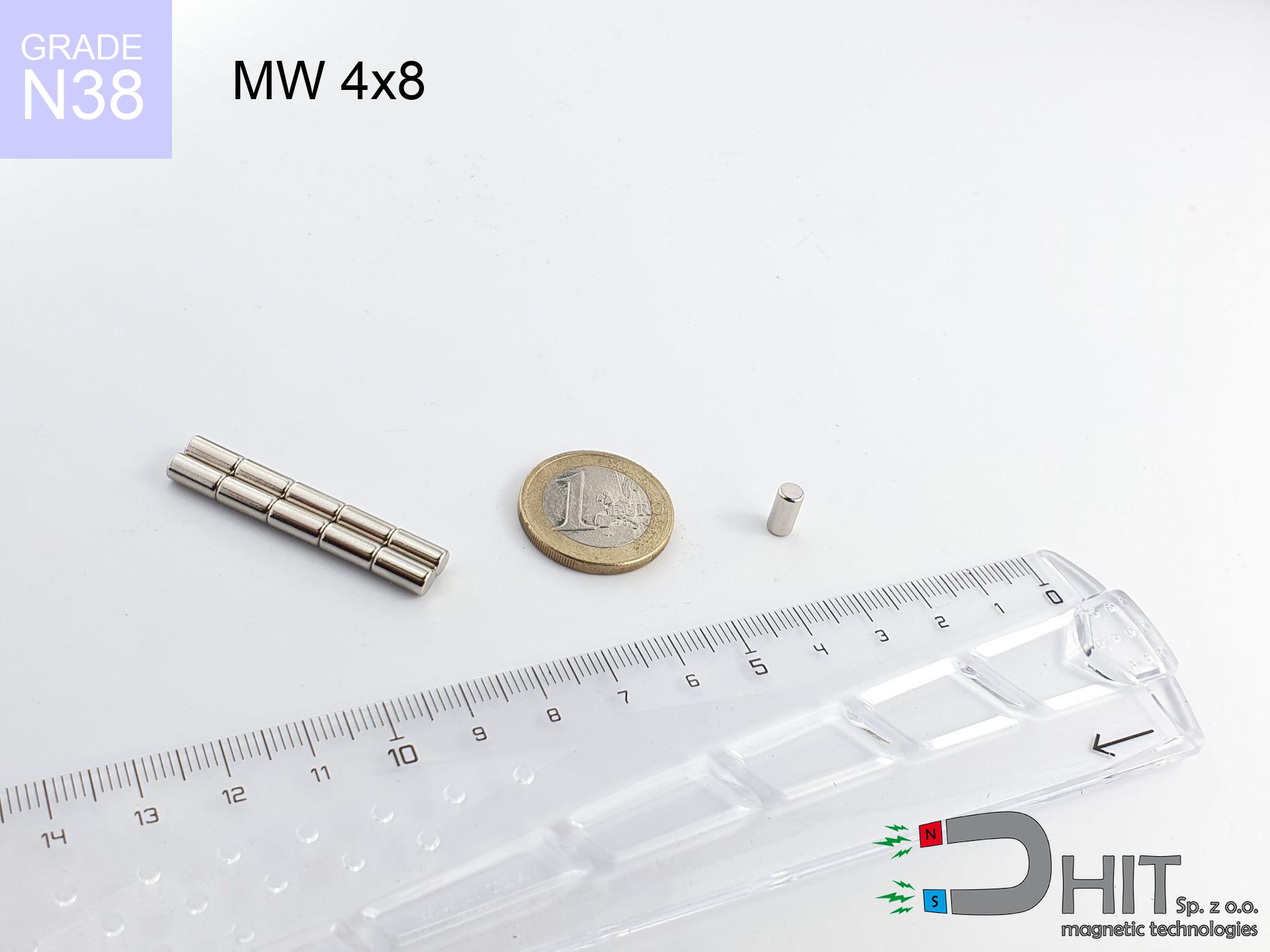SMZR 32x175 / N52 - magnetic separator with handle
magnetic separator with handle
Catalog no 140445
GTIN/EAN: 5906301813514
Diameter Ø
32 mm [±1 mm]
Height
175 mm [±1 mm]
Weight
1070 g
Magnetic Flux
~ 10 000 Gauss [±5%]
553.50 ZŁ with VAT / pcs + price for transport
450.00 ZŁ net + 23% VAT / pcs
bulk discounts:
Need more?
Contact us by phone
+48 888 99 98 98
or drop us a message via
inquiry form
the contact section.
Parameters along with form of neodymium magnets can be estimated using our
online calculation tool.
Same-day processing for orders placed before 14:00.
Detailed specification - SMZR 32x175 / N52 - magnetic separator with handle
Specification / characteristics - SMZR 32x175 / N52 - magnetic separator with handle
| properties | values |
|---|---|
| Cat. no. | 140445 |
| GTIN/EAN | 5906301813514 |
| Production/Distribution | Dhit sp. z o.o. |
| Country of origin | Poland / China / Germany |
| Customs code | 85059029 |
| Diameter Ø | 32 mm [±1 mm] |
| Height | 175 mm [±1 mm] |
| Weight | 1070 g |
| Material Type | Stainless steel AISI 304 / A2 |
| Magnetic Flux | ~ 10 000 Gauss [±5%] |
| Size/Mount Quantity | 2xM8 |
| Polarity | circumferential - 5 poles |
| Casing Tube Thickness | 1 mm |
| Manufacturing Tolerance | ±1 mm |
Magnetic properties of material N52
| properties | values | units |
|---|---|---|
| remenance Br [min. - max.] ? | 14.2-14.7 | kGs |
| remenance Br [min. - max.] ? | 1420-1470 | mT |
| coercivity bHc ? | 10.8-12.5 | kOe |
| coercivity bHc ? | 860-995 | kA/m |
| actual internal force iHc | ≥ 12 | kOe |
| actual internal force iHc | ≥ 955 | kA/m |
| energy density [min. - max.] ? | 48-53 | BH max MGOe |
| energy density [min. - max.] ? | 380-422 | BH max KJ/m |
| max. temperature ? | ≤ 80 | °C |
Physical properties of sintered neodymium magnets Nd2Fe14B at 20°C
| properties | values | units |
|---|---|---|
| Vickers hardness | ≥550 | Hv |
| Density | ≥7.4 | g/cm3 |
| Curie Temperature TC | 312 - 380 | °C |
| Curie Temperature TF | 593 - 716 | °F |
| Specific resistance | 150 | μΩ⋅cm |
| Bending strength | 250 | MPa |
| Compressive strength | 1000~1100 | MPa |
| Thermal expansion parallel (∥) to orientation (M) | (3-4) x 10-6 | °C-1 |
| Thermal expansion perpendicular (⊥) to orientation (M) | -(1-3) x 10-6 | °C-1 |
| Young's modulus | 1.7 x 104 | kg/mm² |
Table 1: Rod construction
SMZR 32x175 / N52
| Parameter | Value | Description / Unit |
|---|---|---|
| Diameter (Ø) | 32 | mm |
| Total length | 175 | mm (L) |
| Active length | 155 | mm |
| Section count | 6 | modules |
| Dead zone | 20 | mm (Blaszka 2mm + Gwint 18mm) |
| Weight (est.) | ~1070 | g |
| Active area | 156 | cm² (Area) |
| Housing material | AISI 304 | 1.4301 (Inox) |
| Surface finish | Ra < 0.8 µm | Polished |
| Temp. class | 80°C | Standard (N) |
| Force loss (at max °C) | -12.8% | Reversible loss (physics) |
| Force (calculated) | 41 | kg (theor.) |
| Induction (surface) | ~10 000 | Gauss (Max) |
Chart 2: Field profile (6 sections)
Chart 3: Temperature performance
Elemental analysis
| iron (Fe) | 64% – 68% |
| neodymium (Nd) | 29% – 32% |
| boron (B) | 1.1% – 1.2% |
| dysprosium (Dy) | 0.5% – 2.0% |
| coating (Ni-Cu-Ni) | < 0.05% |
Environmental data
| recyclability (EoL) | 100% |
| recycled raw materials | ~10% (pre-cons) |
| carbon footprint | low / zredukowany |
| waste code (EWC) | 16 02 16 |
Other offers
Advantages as well as disadvantages of neodymium magnets.
Advantages
- They retain full power for around ten years – the drop is just ~1% (according to analyses),
- Neodymium magnets are characterized by extremely resistant to magnetic field loss caused by external interference,
- A magnet with a shiny silver surface looks better,
- Neodymium magnets create maximum magnetic induction on a small surface, which ensures high operational effectiveness,
- Made from properly selected components, these magnets show impressive resistance to high heat, enabling them to function (depending on their shape) at temperatures up to 230°C and above...
- In view of the ability of precise forming and customization to custom needs, NdFeB magnets can be modeled in a variety of forms and dimensions, which increases their versatility,
- Huge importance in advanced technology sectors – they are commonly used in mass storage devices, motor assemblies, medical devices, and other advanced devices.
- Thanks to their power density, small magnets offer high operating force, with minimal size,
Disadvantages
- At very strong impacts they can break, therefore we recommend placing them in special holders. A metal housing provides additional protection against damage, as well as increases the magnet's durability.
- Neodymium magnets demagnetize when exposed to high temperatures. After reaching 80°C, many of them experience permanent drop of strength (a factor is the shape as well as dimensions of the magnet). We offer magnets specially adapted to work at temperatures up to 230°C marked [AH], which are very resistant to heat
- Due to the susceptibility of magnets to corrosion in a humid environment, we suggest using waterproof magnets made of rubber, plastic or other material resistant to moisture, in case of application outdoors
- We recommend a housing - magnetic mount, due to difficulties in producing threads inside the magnet and complicated forms.
- Possible danger related to microscopic parts of magnets are risky, when accidentally swallowed, which becomes key in the aspect of protecting the youngest. Additionally, small elements of these devices are able to disrupt the diagnostic process medical after entering the body.
- With large orders the cost of neodymium magnets is a challenge,
Lifting parameters
Maximum lifting capacity of the magnet – what it depends on?
- with the use of a yoke made of low-carbon steel, ensuring maximum field concentration
- with a cross-section no less than 10 mm
- with an ideally smooth touching surface
- without any air gap between the magnet and steel
- during pulling in a direction vertical to the plane
- at room temperature
Determinants of practical lifting force of a magnet
- Clearance – existence of foreign body (rust, dirt, air) interrupts the magnetic circuit, which lowers power steeply (even by 50% at 0.5 mm).
- Angle of force application – maximum parameter is obtained only during perpendicular pulling. The resistance to sliding of the magnet along the surface is typically several times smaller (approx. 1/5 of the lifting capacity).
- Steel thickness – insufficiently thick steel causes magnetic saturation, causing part of the power to be escaped into the air.
- Material type – the best choice is pure iron steel. Cast iron may attract less.
- Smoothness – ideal contact is possible only on smooth steel. Rough texture create air cushions, reducing force.
- Heat – neodymium magnets have a negative temperature coefficient. At higher temperatures they lose power, and at low temperatures they can be stronger (up to a certain limit).
Lifting capacity testing was performed on plates with a smooth surface of optimal thickness, under a perpendicular pulling force, whereas under shearing force the load capacity is reduced by as much as 75%. In addition, even a minimal clearance between the magnet and the plate lowers the load capacity.
H&S for magnets
Data carriers
Data protection: Strong magnets can damage payment cards and sensitive devices (pacemakers, medical aids, mechanical watches).
Allergic reactions
It is widely known that the nickel plating (the usual finish) is a common allergen. If you have an allergy, avoid direct skin contact or opt for coated magnets.
Powerful field
Handle with care. Rare earth magnets act from a distance and connect with massive power, often quicker than you can react.
Medical interference
Life threat: Strong magnets can deactivate heart devices and defibrillators. Stay away if you have electronic implants.
Adults only
Only for adults. Small elements can be swallowed, leading to intestinal necrosis. Store out of reach of kids and pets.
Threat to navigation
Remember: rare earth magnets produce a field that disrupts precision electronics. Keep a separation from your mobile, device, and navigation systems.
Finger safety
Protect your hands. Two powerful magnets will snap together instantly with a force of massive weight, crushing everything in their path. Be careful!
Material brittleness
NdFeB magnets are ceramic materials, meaning they are prone to chipping. Collision of two magnets leads to them cracking into shards.
Dust explosion hazard
Combustion risk: Neodymium dust is explosive. Do not process magnets without safety gear as this risks ignition.
Thermal limits
Keep cool. Neodymium magnets are sensitive to heat. If you need operation above 80°C, look for HT versions (H, SH, UH).






![UMGGZ 43x6 [M6] GZ / N38 - rubber magnetic holder external thread UMGGZ 43x6 [M6] GZ / N38 - rubber magnetic holder external thread](https://cdn3.dhit.pl/graphics/products/umg-43x6-m6-gz-miw.jpg)

